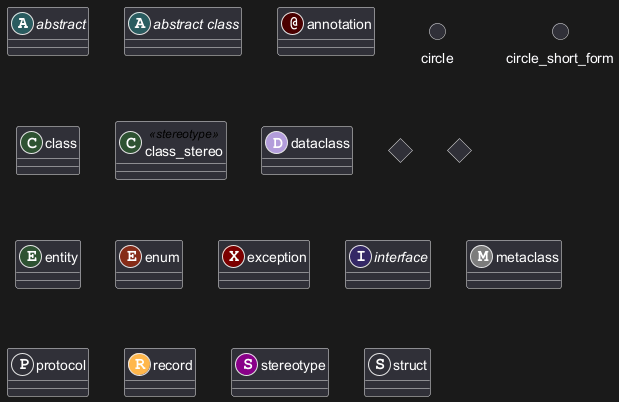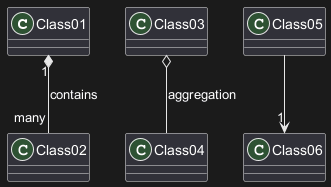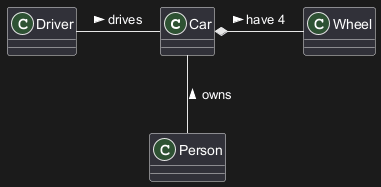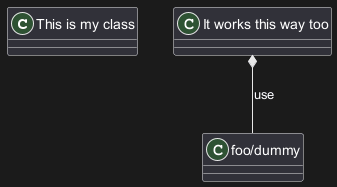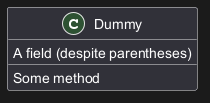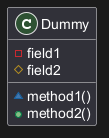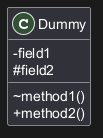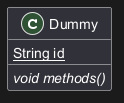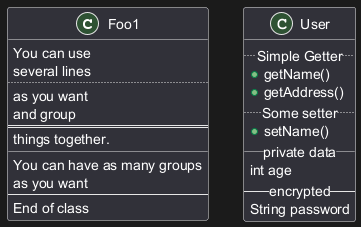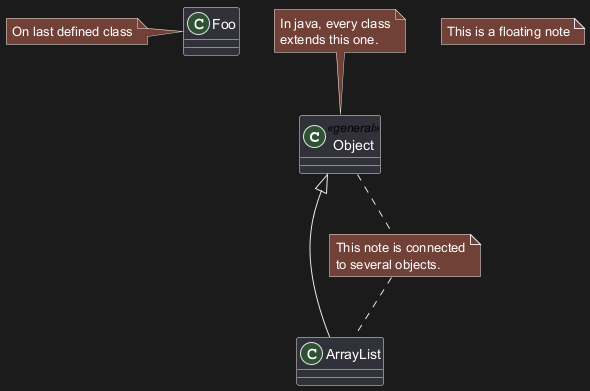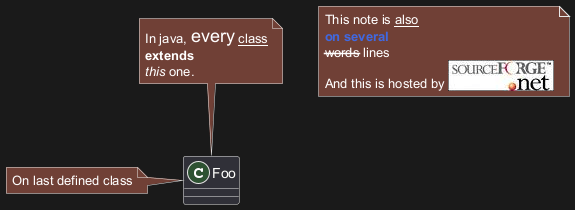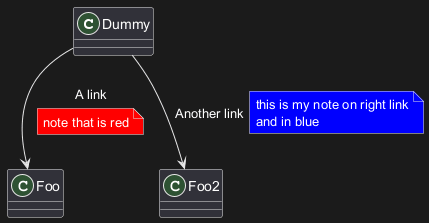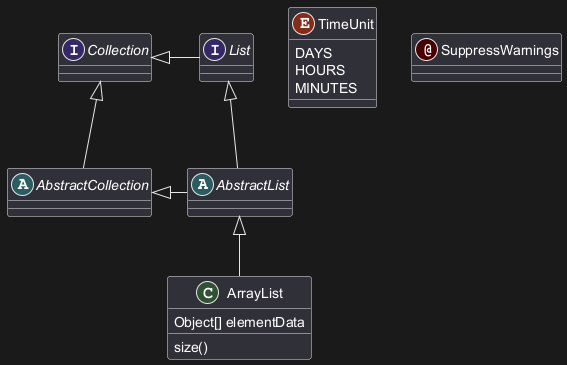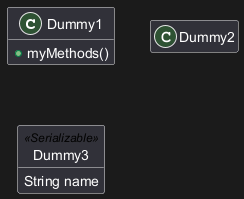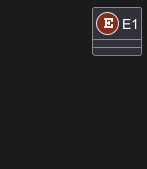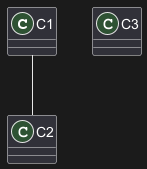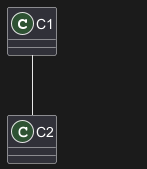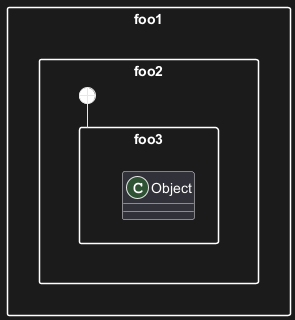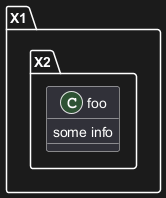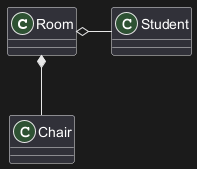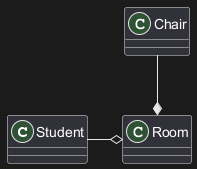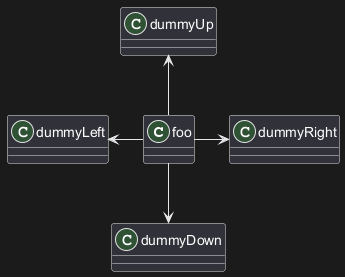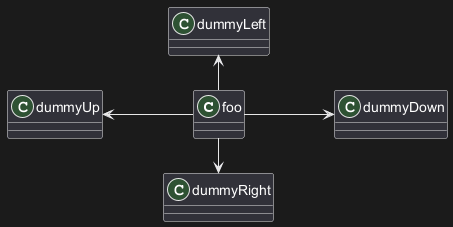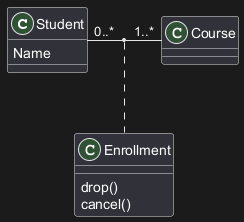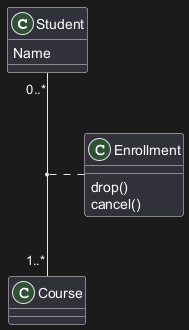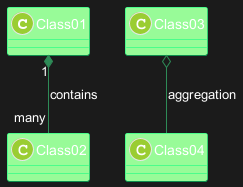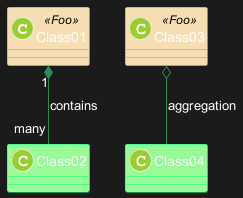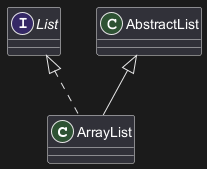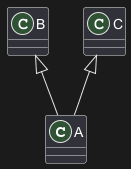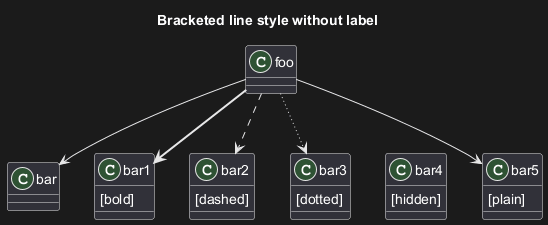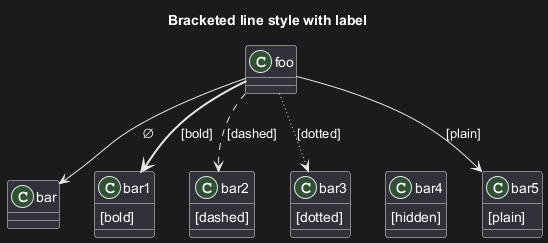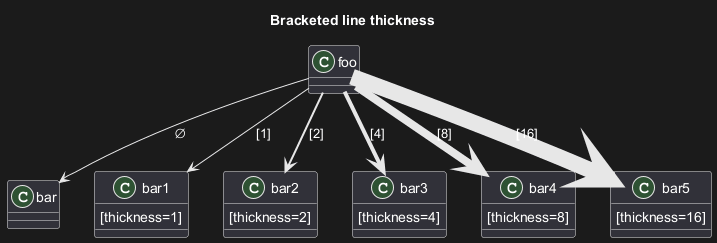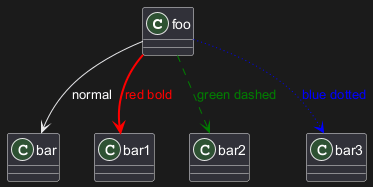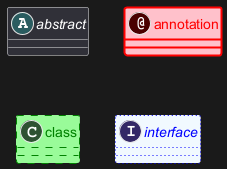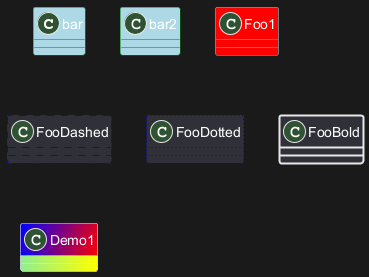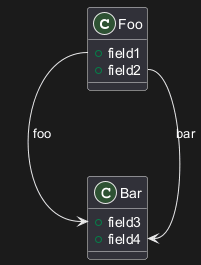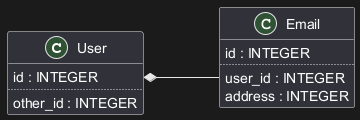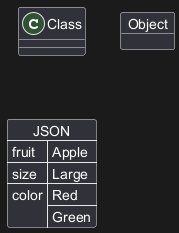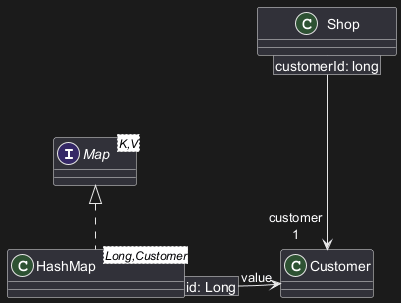Class diagrams are designed using a syntax that mirrors those traditionally employed in programming languages. This resemblance fosters a familiar environment for developers, thereby facilitating an easier and more intuitive diagram creation process.
This design approach is not only succinct but also enables the creation of representations that are both concise and expressive. Moreover, it allows for the portrayal of relationships between classes through a syntax that echoes that of sequence diagrams, paving the way for a fluid and insightful depiction of class interactions.
Beyond structural and relational representations, the class diagram syntax supports further enrichments such as the inclusion of notes and the application of colors, empowering users to create diagrams that are both informative and visually appealing.
You can learn more about some of the
common commands in PlantUML to enhance your diagram creation experience.
|
🎉 Copied!


|
@startuml
abstract abstract
abstract class "abstract class"
annotation annotation
circle circle
() circle_short_form
class class
class class_stereo <<stereotype>>
dataclass dataclass
diamond diamond
<> diamond_short_form
entity entity
enum enum
exception exception
interface interface
metaclass metaclass
protocol protocol
record record
stereotype stereotype
struct struct
@enduml
|
[Ref. for protocol and struct: GH-1028, for exception: QA-16258, for record and dataclass: GH-2232]
클래스 관계는 다음과 같은 부호를 사용합니다.
|
유형
|
기호
|
목적
|
|
확장
|
<|--
|
계층 구조에서 클래스의 특수화
|
|
구현
|
<|..
|
클래스에 의한 인터페이스의 실현
|
|
컴포지션
|
*--
|
부분이 전체 없이는 존재할 수 없음
|
|
집합
|
o--
|
부분이 전체와 독립적으로 존재할 수 있음
|
|
의존성
|
-->
|
객체가 다른 객체를 사용함
|
|
약한 의존성
|
..>
|
더 약한 형태의 의존성
|
-- 는
.. 점선으로 대체 가능합니다.
이러한 규칙들로 다음과 같은 다이어그램을 그리는 것이 가능합니다.
|
🎉 Copied!


|
@startuml
Class01 <|-- Class02
Class03 *-- Class04
Class05 o-- Class06
Class07 .. Class08
Class09 -- Class10
@enduml
|
|
🎉 Copied!


|
@startuml
Class11 <|.. Class12
Class13 --> Class14
Class15 ..> Class16
Class17 ..|> Class18
Class19 <--* Class20
@enduml
|
|
🎉 Copied!


|
@startuml
Class21 #-- Class22
Class23 x-- Class24
Class25 }-- Class26
Class27 +-- Class28
Class29 ^-- Class30
@enduml
|
WARNING
This translation need to be updated. WARNING
관계에서 레이블을 추가하기 위해서는 뒤에
: 를 붙이고 레이블을 작성하면 됩니다.
관계차수를 나타내기 위해서는
""를 이용하여 관계의 양쪽 끝에 작성하면 됩니다.
|
🎉 Copied!


|
@startuml
Class01 "1" *-- "many" Class02 : contains
Class03 o-- Class04 : aggregation
Class05 --> "1" Class06
@enduml
|
< 또는
>을 사용하여 객체가 다른 객체에 대한 흐름 관계를 더 자세히 설명할 수 있습니다.
|
🎉 Copied!


|
@startuml
class Car
Driver - Car : drives >
Car *- Wheel : have 4 >
Car -- Person : < owns
@enduml
|
If you want to use
non-letters in the class (or enum...) display name, you can either :
- Use the
as keyword in the class definition to assign an alias
- Put quotes
"" around the class name
|
🎉 Copied!


|
@startuml
class "This is my class" as class1
class class2 as "It works this way too"
class2 *-- "foo/dummy" : use
@enduml
|
If an alias is assigned to an element, the rest of the file must refer to the element by the alias instead of the name.
Starting names with $
Note that names starting with
$ cannot be hidden or removed later, because
hide and
remove command will consider the name a
$tag instead of a component name. To later remove such elements they must have an alias or must be tagged.
|
🎉 Copied!


|
@startuml
class $C1
class $C2 $C2
class "$C2" as dollarC2
remove $C1
remove $C2
remove dollarC2
@enduml
|
Also note that names starting with $ are valid, but to assign an alias to such element the name must be put between quotes "".
To declare fields and methods, you can use the symbol
: followed by the field's or method's name.
The system checks for parenthesis to choose between methods and fields.
|
🎉 Copied!


|
@startuml
Object <|-- ArrayList
Object : equals()
ArrayList : Object[] elementData
ArrayList : size()
@enduml
|
It is also possible to group between brackets
{} all fields and methods.
Note that the syntax is highly flexible about type/name order.
|
🎉 Copied!


|
@startuml
class Dummy {
String data
void methods()
}
class Flight {
flightNumber : Integer
departureTime : Date
}
@enduml
|
You can use
{field} and
{method} modifiers to
override default behaviour of the parser about fields and methods.
|
🎉 Copied!


|
@startuml
class Dummy {
{field} A field (despite parentheses)
{method} Some method
}
@enduml
|
메소드나 필드들을 정의할 때, 특수문자를 사용하여 관련된 아이템을 가시화할 수 있습니다.
명령어는 다음과 같습니다:
|
Character
|
Icon for field
|
Icon for method
|
Visibility
|
-
|

|

|
private
|
#
|

|

|
protected
|
~
|

|

|
package private
|
+
|

|

|
public
|
|
🎉 Copied!


|
@startuml
class Dummy {
-field1
#field2
~method1()
+method2()
}
@enduml
|
skinparam classAttributeIconSize 0를 사용하여, 아이콘 표시를 끌 수 있습니다.
명령어는 다음과 같습니다:
|
🎉 Copied!


|
@startuml
skinparam classAttributeIconSize 0
class Dummy {
-field1
#field2
~method1()
+method2()
}
@enduml
|
*[Ref. [QA-4755](https://forum.plantuml.net/4755/provide-display-visibility-attributes-private-protected)]*
WARNING
This translation need to be updated. WARNING
You can define static or abstract methods or fields using the
{static}
or
{abstract} modifier.
These modifiers can be used at the start or at the end of the line.
You can also use
{classifier} instead of
{static}.
|
🎉 Copied!


|
@startuml
class Dummy {
{static} String id
{abstract} void methods()
}
@enduml
|
By default, methods and fields are automatically regrouped by PlantUML.
You can use separators to define your own way of ordering fields and methods.
The following separators are possible :
-- .. == __.
You can also use titles within the separators:
|
🎉 Copied!


|
@startuml
class Foo1 {
You can use
several lines
..
as you want
and group
==
things together.
__
You can have as many groups
as you want
--
End of class
}
class User {
.. Simple Getter ..
+ getName()
+ getAddress()
.. Some setter ..
+ setName()
__ private data __
int age
-- encrypted --
String password
}
@enduml
|
Stereotypes are defined with the
class keyword,
<< and
>>.
You can also define notes using
note left of , <code>note
right of</code> ,
note top of ,
note bottom of
keywords.
You can also define a note on the last defined class using
note left,
note right,
note top,
note bottom.
A note can be also define alone with the
note
keywords, then linked to other objects using the
.. symbol.
|
🎉 Copied!


|
@startuml
class Object << general >>
Object <|--- ArrayList
note top of Object : In java, every class\nextends this one.
note "This is a floating note" as N1
note "This note is connected\nto several objects." as N2
Object .. N2
N2 .. ArrayList
class Foo
note left: On last defined class
@enduml
|
WARNING
This translation need to be updated. WARNING
It is also possible to use few HTML tags (See
Creole expression) like :
<b><u><i><s>, <del>, <strike><font color="#AAAAAA"> or <font color="colorName"><color:#AAAAAA> or <color:colorName><size:nn> to change font size<img src="file"> or <img:file>: the file must be accessible by the filesystem
You can also have a note on several lines.
You can also define a note on the last defined element using
note left,
note right,
note top,
note bottom.
|
🎉 Copied!


|
@startuml
class Foo
note left: On last defined class
note top of Foo
In java, <size:18>every</size> <u>class</u>
<b>extends</b>
<i>this</i> one.
end note
note as N1
This note is <u>also</u>
<b><color:royalBlue>on several</color>
<s>words</s> lines
And this is hosted by <img:https://plantuml.com/sourceforge.jpg>
end note
@enduml
|
It is possible to add a note on field (field, attribute, member) or on method.
⚠ Constraint
- This cannot be used with
top or bottom (only left and right are implemented)
- This cannot be used with namespaceSeparator
::
Note on field or method
|
🎉 Copied!


|
@startuml
class A {
{static} int counter
+void {abstract} start(int timeout)
}
note right of A::counter
This member is annotated
end note
note right of A::start
This method is now explained in a UML note
end note
@enduml
|
Note on method with the same name
|
🎉 Copied!


|
@startuml
class A {
{static} int counter
+void {abstract} start(int timeoutms)
+void {abstract} start(Duration timeout)
}
note left of A::counter
This member is annotated
end note
note right of A::"start(int timeoutms)"
This method with int
end note
note right of A::"start(Duration timeout)"
This method with Duration
end note
@enduml
|
[Ref. QA-3474 and QA-5835]
It is possible to add a note on a link, just after the link definition, using
note on link.
You can also use
note left on link,
note right on link,
note top on link,
note bottom on link if you want to change the relative position of the note with the label.
|
🎉 Copied!


|
@startuml
class Dummy
Dummy --> Foo : A link
note on link #red: note that is red
Dummy --> Foo2 : Another link
note right on link #blue
this is my note on right link
and in blue
end note
@enduml
|
<a name="enum" id="enum">You can declare a class as abstract using
"abstract"
or
"abstract class" keywords.</a>
The class will be printed in
italic.</p>
You can use the
interface,
annotation and
enum keywords too.</p>
|
🎉 Copied!


|
@startuml
abstract class AbstractList
abstract AbstractCollection
interface List
interface Collection
List <|-- AbstractList
Collection <|-- AbstractCollection
Collection <|- List
AbstractCollection <|- AbstractList
AbstractList <|-- ArrayList
class ArrayList {
Object[] elementData
size()
}
enum TimeUnit {
DAYS
HOURS
MINUTES
}
annotation SuppressWarnings
@enduml
|
*[Ref. 'Annotation with members' [Issue#458](https://github.com/plantuml/plantuml/issues/458)]*
WARNING
This translation need to be updated. WARNING
You can parameterize the display of classes using the
hide/show
command.
The basic command is:
hide empty members. This
command will hide attributes or methods if they are empty.
Instead of
empty members, you can use:
empty fields or empty attributes for empty fields,empty methods for empty methods,fields or attributes which will hide fields, even if they are described,methods which will hide methods, even if they are described,members which will hide fields and methods, even if they are described,circle for the circled character in front of class name,stereotype for the stereotype.
You can also provide, just after the
hide or
show
keyword:
class for all classes,interface for all interfaces,enum for all enums,<<foo1>> for classes which are stereotyped with foo1,- an existing class name.
You can use several
show/hide commands to define rules and
exceptions.
|
🎉 Copied!


|
@startuml
class Dummy1 {
+myMethods()
}
class Dummy2 {
+hiddenMethod()
}
class Dummy3 <<Serializable>> {
String name
}
hide members
hide <<Serializable>> circle
show Dummy1 methods
show <<Serializable>> fields
@enduml
|
You can also mix with visibility:
|
🎉 Copied!


|
@startuml
hide private members
hide protected members
hide package members
class Foo {
- private
# protected
~ package
}
@enduml
|
[Ref. QA-2913]
You can also use the
show/hide commands to hide classes.
This may be useful if you define a large
!included file,
and if you want to hide some classes after
file inclusion.
|
🎉 Copied!


|
@startuml
class Foo1
class Foo2
Foo2 *-- Foo1
hide Foo2
@enduml
|
You can also use the
remove commands to remove classes.
This may be useful if you define a large
!included file,
and if you want to remove some classes after
file inclusion.
|
🎉 Copied!


|
@startuml
class Foo1
class Foo2
Foo2 *-- Foo1
remove Foo2
@enduml
|
You can put
$tags (using
$) on elements, then remove, hide or restore components either individually or by tags.
By default, all components are displayed:
|
🎉 Copied!


|
@startuml
class C1 $tag13
enum E1
interface I1 $tag13
C1 -- I1
@enduml
|
But you can:
|
🎉 Copied!


|
@startuml
class C1 $tag13
enum E1
interface I1 $tag13
C1 -- I1
hide $tag13
@enduml
|
- or
remove $tag13 components:
|
🎉 Copied!


|
@startuml
class C1 $tag13
enum E1
interface I1 $tag13
C1 -- I1
remove $tag13
@enduml
|
- or
remove $tag13 and restore $tag1 components:
|
🎉 Copied!


|
@startuml
class C1 $tag13 $tag1
enum E1
interface I1 $tag13
C1 -- I1
remove $tag13
restore $tag1
@enduml
|
- or
remove * and restore $tag1 components:
|
🎉 Copied!


|
@startuml
class C1 $tag13 $tag1
enum E1
interface I1 $tag13
C1 -- I1
remove *
restore $tag1
@enduml
|
By default, all classes are displayed:
|
🎉 Copied!


|
@startuml
class C1
class C2
class C3
C1 -- C2
@enduml
|
But you can:
|
🎉 Copied!


|
@startuml
class C1
class C2
class C3
C1 -- C2
hide @unlinked
@enduml
|
- or
remove @unlinked classes:
|
🎉 Copied!


|
@startuml
class C1
class C2
class C3
C1 -- C2
remove @unlinked
@enduml
|
[Adapted from QA-11052]
You can also use bracket
< and
> to define generics usage in a class.
|
🎉 Copied!


|
@startuml
class Foo<? extends Element> {
int size()
}
Foo *- Element
@enduml
|
It is possible to disable this drawing using
skinparam genericDisplay old command.
Usually, a spotted character (C, I, E or A) is used for classes,
interface, enum and abstract classes.
But you can define your own spot for a class when you define the stereotype,
adding a single character and a color, like in this example:
|
🎉 Copied!


|
@startuml
class System << (S,#FF7700) Singleton >>
class Date << (D,orchid) >>
@enduml
|
You can define a package using the
package keyword, and optionally declare a background color
for your package (Using a html color code or name).
Note that package definitions can be nested.
|
🎉 Copied!


|
@startuml
package "Classic Collections" #DDDDDD {
Object <|-- ArrayList
}
package com.plantuml {
Object <|-- Demo1
Demo1 *- Demo2
}
@enduml
|
There are different styles available for packages.
You can specify them either by setting a default style with the command :
skinparam packageStyle,
or by using a stereotype on the package:
|
🎉 Copied!


|
@startuml
scale 750 width
package foo1 <<Node>> {
class Class1
}
package foo2 <<Rectangle>> {
class Class2
}
package foo3 <<Folder>> {
class Class3
}
package foo4 <<Frame>> {
class Class4
}
package foo5 <<Cloud>> {
class Class5
}
package foo6 <<Database>> {
class Class6
}
@enduml
|
You can also define links between packages, like in the following
example:
|
🎉 Copied!


|
@startuml
skinparam packageStyle rectangle
package foo1.foo2 {
}
package foo1.foo2.foo3 {
class Object
}
foo1.foo2 +-- foo1.foo2.foo3
@enduml
|
Starting with version 1.2023.2 (which is online as a beta), PlantUML handles differently namespaces and packages.
There won't be any difference between namespaces and packages anymore: both keywords are now synonymous.
You can define another separator (other than the dot) using
the command :
set namespaceSeparator ???.
|
🎉 Copied!


|
@startuml
set namespaceSeparator ::
class X1::X2::foo {
some info
}
@enduml
|
You can disable automatic package creation using the command
set namespaceSeparator none.
|
🎉 Copied!


|
@startuml
set namespaceSeparator none
class X1.X2.foo {
some info
}
@enduml
|
WARNING
This translation need to be updated. WARNING
You can also define lollipops interface on classes, using the following
syntax:
bar ()- foobar ()-- foofoo -() bar
|
🎉 Copied!


|
@startuml
class foo
bar ()- foo
@enduml
|
By default, links between classes have two dashes
-- and are vertically oriented.
It is possible to use horizontal link by putting a single dash (or dot) like this:
|
🎉 Copied!


|
@startuml
Room o- Student
Room *-- Chair
@enduml
|
You can also change directions by reversing the link:
|
🎉 Copied!


|
@startuml
Student -o Room
Chair --* Room
@enduml
|
It is also possible to change arrow direction by adding
left,
right,
up
or
down keywords inside the arrow:
|
🎉 Copied!


|
@startuml
foo -left-> dummyLeft
foo -right-> dummyRight
foo -up-> dummyUp
foo -down-> dummyDown
@enduml
|
You can shorten the arrow by using only the first character of the direction (for example,
-d- instead of
-down-)
or the two first characters (
-do-).
Please note that you should not abuse this functionality :
Graphviz gives usually good results without tweaking.
And with the
left to right direction parameter:
|
🎉 Copied!


|
@startuml
left to right direction
foo -left-> dummyLeft
foo -right-> dummyRight
foo -up-> dummyUp
foo -down-> dummyDown
@enduml
|
You can define
association class after that a relation has been
defined between two classes, like in this example:
|
🎉 Copied!


|
@startuml
class Student {
Name
}
Student "0..*" - "1..*" Course
(Student, Course) .. Enrollment
class Enrollment {
drop()
cancel()
}
@enduml
|
You can define it in another direction:
|
🎉 Copied!


|
@startuml
class Student {
Name
}
Student "0..*" -- "1..*" Course
(Student, Course) . Enrollment
class Enrollment {
drop()
cancel()
}
@enduml
|
|
🎉 Copied!


|
@startuml
class Station {
+name: string
}
class StationCrossing {
+cost: TimeInterval
}
<> diamond
StationCrossing . diamond
diamond - "from 0..*" Station
diamond - "to 0..* " Station
@enduml
|
[Ref. Incubation: Associations]
You can use the
skinparam
command to change colors and fonts for the drawing.
You can use this command :
|
🎉 Copied!


|
@startuml
skinparam class {
BackgroundColor PaleGreen
ArrowColor SeaGreen
BorderColor SpringGreen
}
skinparam stereotypeCBackgroundColor YellowGreen
Class01 "1" *-- "many" Class02 : contains
Class03 o-- Class04 : aggregation
@enduml
|
You can define specific color and fonts for stereotyped classes.
|
🎉 Copied!


|
@startuml
skinparam class {
BackgroundColor PaleGreen
ArrowColor SeaGreen
BorderColor SpringGreen
BackgroundColor<<Foo>> Wheat
BorderColor<<Foo>> Tomato
}
skinparam stereotypeCBackgroundColor YellowGreen
skinparam stereotypeCBackgroundColor<< Foo >> DimGray
class Class01 <<Foo>>
class Class03 <<Foo>>
Class01 "1" *-- "many" Class02 : contains
Class03 o-- Class04 : aggregation
@enduml
|
Important: unlike class stereotypes, there must be no space between the skin parameter and the following stereotype.
Any of the spaces shown as
_ below will cause
all skinparams to be ignored,
see
discord discussion
and
issue #1932:
BackgroundColor_<<Foo>> Wheatskinparam stereotypeCBackgroundColor_<<Foo>> DimGray
You can declare individual colors for classes, notes etc using the # notation.
You can use standard color names or RGB codes in various notations, see
Colors.
You can also use color gradient for background colors, with the following syntax:
two colors names separated either by:
depending on the direction of the gradient.
For example:
|
🎉 Copied!


|
@startuml
skinparam backgroundcolor AntiqueWhite/Gold
skinparam classBackgroundColor Wheat|CornflowerBlue
class Foo #red-green
note left of Foo #blue\9932CC
this is my
note on this class
end note
package example #GreenYellow/LightGoldenRodYellow {
class Dummy
}
@enduml
|
Sometimes, the default layout is not perfect...
You can use
together keyword to group some classes together :
the layout engine will try to group them (as if they were in the same package).
You can also use
hidden links to force the layout.
|
🎉 Copied!


|
@startuml
class Bar1
class Bar2
together {
class Together1
class Together2
class Together3
}
Together1 - Together2
Together2 - Together3
Together2 -[hidden]--> Bar1
Bar1 -[hidden]> Bar2
@enduml
|
Sometimes, you will get some very large image files.
You can use the
page (hpages)x(vpages) command to
split the generated image into several files :
hpages is a number that indicated the number of horizontal pages,
and
vpages is a number that indicated the number of vertical pages.
You can also use some specific skinparam settings to put borders on splitted pages (see example).
|
🎉 Copied!


|
@startuml
' Split into 4 pages
page 2x2
skinparam pageMargin 10
skinparam pageExternalColor gray
skinparam pageBorderColor black
class BaseClass
namespace net.dummy #DDDDDD {
.BaseClass <|-- Person
Meeting o-- Person
.BaseClass <|- Meeting
}
namespace net.foo {
net.dummy.Person <|- Person
.BaseClass <|-- Person
net.dummy.Meeting o-- Person
}
BaseClass <|-- net.unused.Person
@enduml
|
It is also possible to use
extends and
implements keywords.
|
🎉 Copied!


|
@startuml
class ArrayList implements List
class ArrayList extends AbstractList
@enduml
|
|
🎉 Copied!


|
@startuml
class A extends B, C {
}
@enduml
|
[Ref. QA-2239]
Line style
It's also possible to have explicitly
bold,
dashed,
dotted,
hidden or
plain relation, links or arrows:
|
🎉 Copied!


|
@startuml
title Bracketed line style without label
class foo
class bar
bar1 : [bold]
bar2 : [dashed]
bar3 : [dotted]
bar4 : [hidden]
bar5 : [plain]
foo --> bar
foo -[bold]-> bar1
foo -[dashed]-> bar2
foo -[dotted]-> bar3
foo -[hidden]-> bar4
foo -[plain]-> bar5
@enduml
|
|
🎉 Copied!


|
@startuml
title Bracketed line style with label
class foo
class bar
bar1 : [bold]
bar2 : [dashed]
bar3 : [dotted]
bar4 : [hidden]
bar5 : [plain]
foo --> bar : ∅
foo -[bold]-> bar1 : [bold]
foo -[dashed]-> bar2 : [dashed]
foo -[dotted]-> bar3 : [dotted]
foo -[hidden]-> bar4 : [hidden]
foo -[plain]-> bar5 : [plain]
@enduml
|
[Adapted from QA-4181]
Line color
|
🎉 Copied!


|
@startuml
title Bracketed line color
class foo
class bar
bar1 : [#red]
bar2 : [#green]
bar3 : [#blue]
foo --> bar
foo -[#red]-> bar1 : [#red]
foo -[#green]-> bar2 : [#green]
foo -[#blue]-> bar3 : [#blue]
'foo -[#blue;#yellow;#green]-> bar4
@enduml
|
Line thickness
|
🎉 Copied!


|
@startuml
title Bracketed line thickness
class foo
class bar
bar1 : [thickness=1]
bar2 : [thickness=2]
bar3 : [thickness=4]
bar4 : [thickness=8]
bar5 : [thickness=16]
foo --> bar : ∅
foo -[thickness=1]-> bar1 : [1]
foo -[thickness=2]-> bar2 : [2]
foo -[thickness=4]-> bar3 : [4]
foo -[thickness=8]-> bar4 : [8]
foo -[thickness=16]-> bar5 : [16]
@enduml
|
[Ref. QA-4949]
Mix
|
🎉 Copied!


|
@startuml
title Bracketed line style mix
class foo
class bar
bar1 : [#red,thickness=1]
bar2 : [#red,dashed,thickness=2]
bar3 : [#green,dashed,thickness=4]
bar4 : [#blue,dotted,thickness=8]
bar5 : [#blue,plain,thickness=16]
foo --> bar : ∅
foo -[#red,thickness=1]-> bar1 : [#red,1]
foo -[#red,dashed,thickness=2]-> bar2 : [#red,dashed,2]
foo -[#green,dashed,thickness=4]-> bar3 : [#green,dashed,4]
foo -[#blue,dotted,thickness=8]-> bar4 : [blue,dotted,8]
foo -[#blue,plain,thickness=16]-> bar5 : [blue,plain,16]
@enduml
|
You can change the
color or style of individual relation or arrows using the inline following notation:
#color;line.[bold|dashed|dotted];text:color
|
🎉 Copied!


|
@startuml
class foo
foo --> bar : normal
foo --> bar1 #line:red;line.bold;text:red : red bold
foo --> bar2 #green;line.dashed;text:green : green dashed
foo --> bar3 #blue;line.dotted;text:blue : blue dotted
@enduml
|
[See similar feature on deployment]
You can change the
color or style of individual class using the two following notations:
With background color first (
#color), then line style and line color (
##[style]color )
|
🎉 Copied!


|
@startuml
abstract abstract
annotation annotation #pink ##[bold]red
class class #palegreen ##[dashed]green
interface interface #aliceblue ##[dotted]blue
@enduml
|
[Ref. QA-1487]
#[color|back:color];header:color;line:color;line.[bold|dashed|dotted];text:color
|
🎉 Copied!


|
@startuml
abstract abstract
annotation annotation #pink;line:red;line.bold;text:red
class class #palegreen;line:green;line.dashed;text:green
interface interface #aliceblue;line:blue;line.dotted;text:blue
@enduml
|
First original example:
|
🎉 Copied!


|
@startuml
class bar #line:green;back:lightblue
class bar2 #lightblue;line:green
class Foo1 #back:red;line:00FFFF
class FooDashed #line.dashed:blue
class FooDotted #line.dotted:blue
class FooBold #line.bold
class Demo1 #back:lightgreen|yellow;header:blue/red
@enduml
|
[Ref. QA-3770]
|
🎉 Copied!


|
@startuml
class Foo {
+ field1
+ field2
}
class Bar {
+ field3
+ field4
}
Foo::field1 --> Bar::field3 : foo
Foo::field2 --> Bar::field4 : bar
@enduml
|
[Ref. QA-3636]
|
🎉 Copied!


|
@startuml
left to right direction
class User {
id : INTEGER
..
other_id : INTEGER
}
class Email {
id : INTEGER
..
user_id : INTEGER
address : INTEGER
}
User::id *-- Email::user_id
@enduml
|
[Ref. QA-5261]
You can merge all arrow heads using the
skinparam groupInheritance, with a threshold as parameter.
GroupInheritance 1 (no grouping)
|
🎉 Copied!


|
@startuml
skinparam groupInheritance 1
A1 <|-- B1
A2 <|-- B2
A2 <|-- C2
A3 <|-- B3
A3 <|-- C3
A3 <|-- D3
A4 <|-- B4
A4 <|-- C4
A4 <|-- D4
A4 <|-- E4
@enduml
|
GroupInheritance 2 (grouping from 2)
|
🎉 Copied!


|
@startuml
skinparam groupInheritance 2
A1 <|-- B1
A2 <|-- B2
A2 <|-- C2
A3 <|-- B3
A3 <|-- C3
A3 <|-- D3
A4 <|-- B4
A4 <|-- C4
A4 <|-- D4
A4 <|-- E4
@enduml
|
GroupInheritance 3 (grouping only from 3)
|
🎉 Copied!


|
@startuml
skinparam groupInheritance 3
A1 <|-- B1
A2 <|-- B2
A2 <|-- C2
A3 <|-- B3
A3 <|-- C3
A3 <|-- D3
A4 <|-- B4
A4 <|-- C4
A4 <|-- D4
A4 <|-- E4
@enduml
|
GroupInheritance 4 (grouping only from 4)
|
🎉 Copied!


|
@startuml
skinparam groupInheritance 4
A1 <|-- B1
A2 <|-- B2
A2 <|-- C2
A3 <|-- B3
A3 <|-- C3
A3 <|-- D3
A4 <|-- B4
A4 <|-- C4
A4 <|-- D4
A4 <|-- E4
@enduml
|
[Ref. QA-3193, and Defect QA-13532]
Simple example
|
🎉 Copied!


|
@startuml
class Class
object Object
json JSON {
"fruit":"Apple",
"size":"Large",
"color": ["Red", "Green"]
}
@enduml
|
[Ref. QA-15481]
For another example, see on
JSON page.
[From V1.2023.2+, and V1.2023.5]
|
🎉 Copied!


|
@startuml
class A.B.C.D.Z {
}
@enduml
|
|
🎉 Copied!


|
@startuml
set separator none
class A.B.C.D.Z {
}
@enduml
|
|
🎉 Copied!


|
@startuml
!pragma useIntermediatePackages false
class A.B.C.D.Z {
}
@enduml
|
|
🎉 Copied!


|
@startuml
set separator none
package A.B.C.D {
class Z {
}
}
@enduml
|
[Ref. GH-1352]
Minimal example
|
🎉 Copied!


|
@startuml
class class1
class class2
class1 [Qualifier] - class2
@enduml
|
[Ref. QA-16397, GH-1467]
Another example
|
🎉 Copied!


|
@startuml
interface Map<K,V>
class HashMap<Long,Customer>
Map <|.. HashMap
Shop [customerId: long] ---> "customer\n1" Customer
HashMap [id: Long] -r-> "value" Customer
@enduml
|
You can change (whole) diagram orientation with:
top to bottom direction (by default)left to right direction
Top to bottom (by default)
With Graphviz (layout engine by default)
The main rule is:
Nested element first, then simple element.
|
🎉 Copied!


|
@startuml
class a
class b
package A {
class a1
class a2
class a3
class a4
class a5
package sub_a {
class sa1
class sa2
class sa3
}
}
package B {
class b1
class b2
class b3
class b4
class b5
package sub_b {
class sb1
class sb2
class sb3
}
}
@enduml
|
With Smetana (internal layout engine)
The main rule is the opposite:
Simple element first, then nested element.
|
🎉 Copied!


|
@startuml
!pragma layout smetana
class a
class b
package A {
class a1
class a2
class a3
class a4
class a5
package sub_a {
class sa1
class sa2
class sa3
}
}
package B {
class b1
class b2
class b3
class b4
class b5
package sub_b {
class sb1
class sb2
class sb3
}
}
@enduml
|
Left to right
With Graphviz (layout engine by default)
|
🎉 Copied!


|
@startuml
left to right direction
class a
class b
package A {
class a1
class a2
class a3
class a4
class a5
package sub_a {
class sa1
class sa2
class sa3
}
}
package B {
class b1
class b2
class b3
class b4
class b5
package sub_b {
class sb1
class sb2
class sb3
}
}
@enduml
|
With Smetana (internal layout engine)
|
🎉 Copied!


|
@startuml
!pragma layout smetana
left to right direction
class a
class b
package A {
class a1
class a2
class a3
class a4
class a5
package sub_a {
class sa1
class sa2
class sa3
}
}
package B {
class b1
class b2
class b3
class b4
class b5
package sub_b {
class sb1
class sb2
class sb3
}
}
@enduml
|
